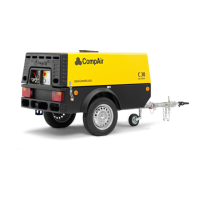86
7.1 Initial operation
Transport inspection
Every CompAir screw compressor
has already run in the factory and has
already undergone a thorough test before
shipment. This test ensures that the
compressor complies with the given data
and works perfectly. Independent of
the care taken in the factory, it is still
possible for the compressor to be damaged
during transport. For this reason it is
recommended that the unit should be
examined for possible damage during
transport.
Remove any transport seals (dummy
flange, plugs, etc.) and dehydrating agents
before start-up. Distribution tubes and
connection lines must have the specified
dimensions and must be suitable for use
with the max. operating pressure and the
media to be taken up.
During the first hours of operation, the
compressor should be observed in order
to be able to ascertain any possible
malfunctions.
Transport safety locking of the towing
arrangement
Fig. 17
The towing arrangement is positioned
vertically in accordance with Figure 17.
The clamp must be released and the
spacer removed on initial use. The towing
arrangement can then be adjusted
according to the required trailer height and
locked with the clamp/ratchet (see here
Undercarriage Operating Instructions).
7.2 Operating elements
Operating panel:
Fig. 18
1 Ignition switch
2 Start / Run valve
3 Hours of operation counter
4 "Fault" pilot lamp
5 "Fuel shortage" warning lamp
6 "Battery charge" warning lamp
7 Operating pressure gauge
Fig. 19
8 Compressor temperature display
(optional)
7.3 Start-up
Danger
Before starting up, make sure that no
one is in the danger area of the engine /
screw compressor.
Compressors may not be operated in
hazardous environments unless they
have been specially designed for this
purpose (e.g. exhaust protected against
emission of flying sparks etc.).
After service work has been completed:
Make sure that all protective devices
have been refitted and that all tools
have been removed.
The exhaust emissions of combustion
engines contain carbon monoxide - a
lethal gas. If a machine with such an
engine has to work in an enclosed
room, the exhaust gases must therefore
be conducted out of doors by means of
a pipe or hose with an internal diameter
of at least 100 mm. The use of extraction
systems is highly recommended in test
rooms for mobile machines.
Only operate the compressor with the
hood closed. The hood may only be
opened briefly for minor adjustments
while the compressor is running.
Skilled personnel only are authorized to
work with the hood open.
When working with the screw
compressor in operation and with the
shielding/hood open, wear ear
protection.
Caution: this may impair
communication between persons.
Warnings may not be heard. Inform
supervisor.
Attention
Opening the hood interferes with the
flow of cool air in the compressor
section.
Full sound-insulating is only achieved
when the hood is closed.
Check the oil levels in the pressure tank
and in the engine of the compressor
each time before start-up.
Do not start the compressor unless the
air tapping cocks are closed.
Note
It is not possible to start up the compressor
if there is insufficient fuel is available.
Starting up the compressor:
* Close air tapping cocks
* Turn ingnition switch to position "On" I;
the indicator lamps “Battery charge” and
“Fault” come on.
* Turn the ignition switch further to
position
.
* Hold the ignition switch in position
until the engine starts running and the
“Battery charge” and “Fault” indicator
lamps go off.
* Release the ignition switch.
* If the engine has not started after
15 seconds at the latest, turn the ignition
key back to position
(Off-Aus). As
soon as the starter has reached a
standstill and the pressure tank is no
longer under pressure, the engine can
be started again.
* After the start, the engine runs at the
idling speed and the compressor at
reduced pressure.
Transport safety locking
8
7. Putting the compressor into operation
12
34567

